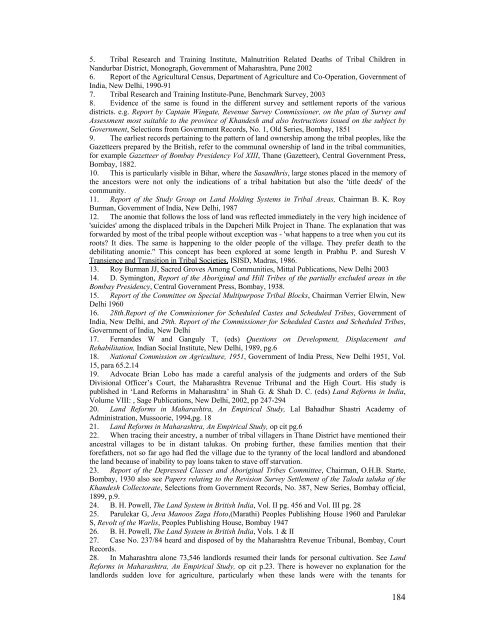Living on the Margins. Minorities in South Asia - EURAC
Living on the Margins. Minorities in South Asia - EURAC
Living on the Margins. Minorities in South Asia - EURAC
- TAGS
- minorities
- eurac
- www.eurac.edu
Create successful ePaper yourself
Turn your PDF publications into a flip-book with our unique Google optimized e-Paper software.
5. Tribal Research and Tra<strong>in</strong><strong>in</strong>g Institute, Malnutriti<strong>on</strong> Related Deaths of Tribal Children <strong>in</strong><br />
Nandurbar District, M<strong>on</strong>ograph, Government of Maharashtra, Pune 2002<br />
6. Report of <strong>the</strong> Agricultural Census, Department of Agriculture and Co-Operati<strong>on</strong>, Government of<br />
India, New Delhi, 1990-91<br />
7. Tribal Research and Tra<strong>in</strong><strong>in</strong>g Institute-Pune, Benchmark Survey, 2003<br />
8. Evidence of <strong>the</strong> same is found <strong>in</strong> <strong>the</strong> different survey and settlement reports of <strong>the</strong> various<br />
districts. e.g. Report by Capta<strong>in</strong> W<strong>in</strong>gate, Revenue Survey Commissi<strong>on</strong>er, <strong>on</strong> <strong>the</strong> plan of Survey and<br />
Assessment most suitable to <strong>the</strong> prov<strong>in</strong>ce of Khandesh and also Instructi<strong>on</strong>s issued <strong>on</strong> <strong>the</strong> subject by<br />
Government, Selecti<strong>on</strong>s from Government Records, No. 1, Old Series, Bombay, 1851<br />
9. The earliest records perta<strong>in</strong><strong>in</strong>g to <strong>the</strong> pattern of land ownership am<strong>on</strong>g <strong>the</strong> tribal peoples, like <strong>the</strong><br />
Gazetteers prepared by <strong>the</strong> British, refer to <strong>the</strong> communal ownership of land <strong>in</strong> <strong>the</strong> tribal communities,<br />
for example Gazetteer of Bombay Presidency Vol XIII, Thane (Gazetteer), Central Government Press,<br />
Bombay, 1882.<br />
10. This is particularly visible <strong>in</strong> Bihar, where <strong>the</strong> Sasandhris, large st<strong>on</strong>es placed <strong>in</strong> <strong>the</strong> memory of<br />
<strong>the</strong> ancestors were not <strong>on</strong>ly <strong>the</strong> <strong>in</strong>dicati<strong>on</strong>s of a tribal habitati<strong>on</strong> but also <strong>the</strong> 'title deeds' of <strong>the</strong><br />
community.<br />
11. Report of <strong>the</strong> Study Group <strong>on</strong> Land Hold<strong>in</strong>g Systems <strong>in</strong> Tribal Areas, Chairman B. K. Roy<br />
Burman, Government of India, New Delhi, 1987<br />
12. The anomie that follows <strong>the</strong> loss of land was reflected immediately <strong>in</strong> <strong>the</strong> very high <strong>in</strong>cidence of<br />
'suicides' am<strong>on</strong>g <strong>the</strong> displaced tribals <strong>in</strong> <strong>the</strong> Dapcheri Milk Project <strong>in</strong> Thane. The explanati<strong>on</strong> that was<br />
forwarded by most of <strong>the</strong> tribal people without excepti<strong>on</strong> was - 'what happens to a tree when you cut its<br />
roots? It dies. The same is happen<strong>in</strong>g to <strong>the</strong> older people of <strong>the</strong> village. They prefer death to <strong>the</strong><br />
debilitat<strong>in</strong>g anomie." This c<strong>on</strong>cept has been explored at some length <strong>in</strong> Prabhu P. and Suresh V<br />
Transience and Transiti<strong>on</strong> <strong>in</strong> Tribal Societies, ISISD, Madras, 1986.<br />
13. Roy Burman JJ, Sacred Groves Am<strong>on</strong>g Communities, Mittal Publicati<strong>on</strong>s, New Delhi 2003<br />
14. D. Sym<strong>in</strong>gt<strong>on</strong>, Report of <strong>the</strong> Aborig<strong>in</strong>al and Hill Tribes of <strong>the</strong> partially excluded areas <strong>in</strong> <strong>the</strong><br />
Bombay Presidency, Central Government Press, Bombay, 1938.<br />
15. Report of <strong>the</strong> Committee <strong>on</strong> Special Multipurpose Tribal Blocks, Chairman Verrier Elw<strong>in</strong>, New<br />
Delhi 1960<br />
16. 28th.Report of <strong>the</strong> Commissi<strong>on</strong>er for Scheduled Castes and Scheduled Tribes, Government of<br />
India, New Delhi, and 29th. Report of <strong>the</strong> Commissi<strong>on</strong>er for Scheduled Castes and Scheduled Tribes,<br />
Government of India, New Delhi<br />
17. Fernandes W and Ganguly T, (eds) Questi<strong>on</strong>s <strong>on</strong> Development, Displacement and<br />
Rehabilitati<strong>on</strong>, Indian Social Institute, New Delhi, 1989, pg.6<br />
18. Nati<strong>on</strong>al Commissi<strong>on</strong> <strong>on</strong> Agriculture, 1951, Government of India Press, New Delhi 1951, Vol.<br />
15, para 65.2.14<br />
19. Advocate Brian Lobo has made a careful analysis of <strong>the</strong> judgments and orders of <strong>the</strong> Sub<br />
Divisi<strong>on</strong>al Officer’s Court, <strong>the</strong> Maharashtra Revenue Tribunal and <strong>the</strong> High Court. His study is<br />
published <strong>in</strong> ‘Land Reforms <strong>in</strong> Maharashtra’ <strong>in</strong> Shah G. & Shah D. C. (eds) Land Reforms <strong>in</strong> India,<br />
Volume VIII: , Sage Publicati<strong>on</strong>s, New Delhi, 2002, pp 247-294<br />
20. Land Reforms <strong>in</strong> Maharashtra, An Empirical Study, Lal Bahadhur Shastri Academy of<br />
Adm<strong>in</strong>istrati<strong>on</strong>, Mussoorie, 1994,pg. 18<br />
21. Land Reforms <strong>in</strong> Maharashtra, An Empirical Study, op cit pg.6<br />
22. When trac<strong>in</strong>g <strong>the</strong>ir ancestry, a number of tribal villagers <strong>in</strong> Thane District have menti<strong>on</strong>ed <strong>the</strong>ir<br />
ancestral villages to be <strong>in</strong> distant talukas. On prob<strong>in</strong>g fur<strong>the</strong>r, <strong>the</strong>se families menti<strong>on</strong> that <strong>the</strong>ir<br />
forefa<strong>the</strong>rs, not so far ago had fled <strong>the</strong> village due to <strong>the</strong> tyranny of <strong>the</strong> local landlord and aband<strong>on</strong>ed<br />
<strong>the</strong> land because of <strong>in</strong>ability to pay loans taken to stave off starvati<strong>on</strong>.<br />
23. Report of <strong>the</strong> Depressed Classes and Aborig<strong>in</strong>al Tribes Committee, Chairman, O.H.B. Starte,<br />
Bombay, 1930 also see Papers relat<strong>in</strong>g to <strong>the</strong> Revisi<strong>on</strong> Survey Settlement of <strong>the</strong> Taloda taluka of <strong>the</strong><br />
Khandesh Collectorate, Selecti<strong>on</strong>s from Government Records, No. 387, New Series, Bombay official,<br />
1899, p.9.<br />
24. B. H. Powell, The Land System <strong>in</strong> British India, Vol. II pg. 456 and Vol. III pg. 28<br />
25. Parulekar G, Jeva Manoos Zaga Hoto,(Marathi) Peoples Publish<strong>in</strong>g House 1960 and Parulekar<br />
S, Revolt of <strong>the</strong> Warlis, Peoples Publish<strong>in</strong>g House, Bombay 1947<br />
26. B. H. Powell, The Land System <strong>in</strong> British India, Vols. 1 & II<br />
27. Case No. 237/84 heard and disposed of by <strong>the</strong> Maharashtra Revenue Tribunal, Bombay, Court<br />
Records.<br />
28. In Maharashtra al<strong>on</strong>e 73,546 landlords resumed <strong>the</strong>ir lands for pers<strong>on</strong>al cultivati<strong>on</strong>. See Land<br />
Reforms <strong>in</strong> Maharashtra, An Empirical Study, op cit p.23. There is however no explanati<strong>on</strong> for <strong>the</strong><br />
landlords sudden love for agriculture, particularly when <strong>the</strong>se lands were with <strong>the</strong> tenants for<br />
184

















